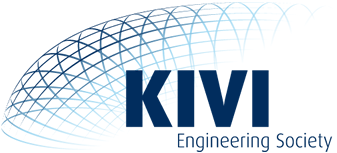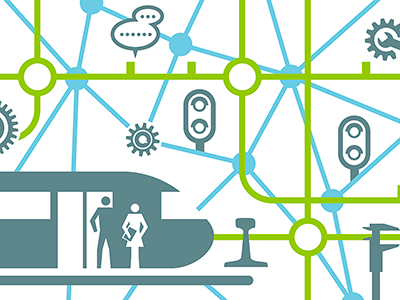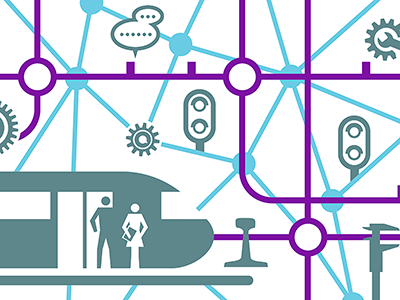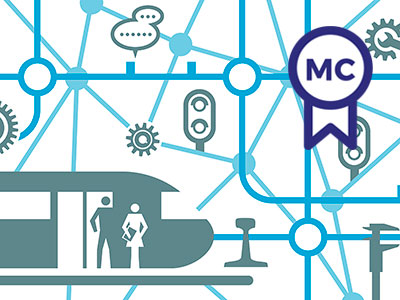Overview
This course will enhance your decision-making abilities and provide you with strategies to ensure greater reliability in ever-changing situations. You will learn how to optimize the operation and capacity of the railway network and structure, align and optimize the various transport modes, and manage the planning and phases of complex railway systems in a real-time environment.
This course is part of our railway engineering series which focuses on an integrated perspective to the practical resolution of daily challenges to achieve a more reliable, safe and high-comfort railway network, transporting people and goods in a fast and efficient way.
Design – Operations – Performance
The central element of this course is 'operations', while the two other content courses are dedicated to 'design' and 'performance'. A final fourth course will integrate all three topics.
To meet the demand of more and more travellers, it is important to have a robust system and a high traffic flow. During these six weeks, we will take a closer look at:
1) Markets, stakeholders, the logistic chain and governance
2) Structure and design of a timetabling, design for traffic control and predefined solutions
3) Re-evaluating decision-making and optimizing infra-capacity
Dealing with railway issues today
The automatization and digitalization of railway systems, including the adoption of new technologies, presents new challenges for all aspects of railway operations. They require new types of problem-solving and optimization at a time when the use of railway networks is increasing every year.
Knowing how to anticipate unforeseen situations is essential to keep customer inconvenience to a minimum and to support railway professionals to make informed decisions when facing complex dilemmas. This course will give you a framework so you can consider travellers' needs, different stakeholders' positions and overall governance, while daring to question the current system and (re)evaluate priorities.
After taking this course, you will be able to:
- Balance and optimize scheduling decisions, both for daily use and complex situations, taking the needs and demands of the different stakeholders into account.
- Apply tools and techniques to design and improve reliable and robust train scheduling that can respond more effectively to unforeseen circumstances and unexpected situations.
- Develop strategies to optimize the use of the railway network by recognizing infra-capacity, availability of rolling stock, deployment of staff, communication methods and new technologies.
- Create a robust railway system, ensuring comfort, reliability and safety, while making the best possible use of the existing (or potentially new) infrastructure.
This course is part of our Professional Certificate Program in Railway Engineering, endorsed by:

Note: This course is offered twice a year, usually in May and November.
Details
Course Syllabus:
Week 1: Markets and stakeholders
The objective of railway systems is to facilitate and optimize the transport of people and goods. The system involves many different parties, but the passengers (and goods) have a central position. During this week, you will learn about the needs and demands of the passengers, shippers and other stakeholders.
Week 2: Time-Table Design
What is needed to translate demand in a coherent time-table? What are the key attributes of a time-table that can be learned from patterns and symmetry? What are the limitations and conflicting elements that affect the usage and availability of resources and deployment of infrastructure, trains and staff?
Week 3: Traffic Control
How can we facilitate, control and anticipate unplanned actions, such as last-minute orders, external factors and incident-management? In a robust network, we can execute pre-defined measures, reschedule rolling stock and staff and coordinate recovery of the time-table service after disruptions.
Week 4: Re-evaluating Decision-making
During the fourth week, we not only analyse the current situation but also reflect on why things are the way they are. By re-evaluating priorities, we aim to redefine and restate the main goal of railway infrastructure. Daring to question the system challenges us to re-evaluate priorities and reflect on the actual goal of having railway infrastructure. What solution would be best suited for the traveller?
Week 5: Optimizing Infra-Capacity
ERTMS (European Rail Traffic Management System) aims to improve the capacity of tracks. In short, the main goal of ERTMS is to make optimal use of the existing railway infrastructure, with safe maximum traffic capacity and minimal use of energy, by means of a computerized system. We consider the opportunities of the system combined with the knowledge and developments of today. Besides that, we ask the question whether stakeholders can align towards an overall goal, rather than following their own interests.
Week 6: Case Study
We challenge you to put your knowledge of the whole course together by analysing a final case study on railway operations and stakeholders, where you re-evaluate the use and position of Amsterdam Central Station in the Dutch railway system.
Follow our full program
This course is one of a series of professional education courses devoted to railway engineering. If you are interested in developing a comprehensive and integrated systems perspective on railway engineering, join the full Professional Certificate Program, which consists of three courses and a Capstone Project.
The subsequent courses in this series are:
- Railway Engineering: Performance over Time
- Railway Engineering: Track and Train Interaction
- Railway Engineering: Capstone Project
Overall, this full program will enable rail professionals in managerial or advisory roles to develop a good operational understanding of a systems view of railway networks to enhance the quality of their investment decisions, innovation initiatives, analysis of technical failures, project documentation and system optimization.
Qualifications
Certificates
If you successfully complete this course, you will earn a professional education certificate and you are eligible to receive 3.0 Continuing Education Units (CEUs).
Microcredential
if you successfully complete all the courses that are part of our Railway Engineering series (Track and Train Interaction, Real Time Operations, Performance over Time, and Capstone Project), you will be entitled to a Microcredential. For more information on Microcredentials visit this page.
Admission
This course is primarily geared towards working professionals.
To fully benefit from this course, you should have basic knowledge and working experience in railways.
Interested in enrolling in our full program?
This course is part of our Professional Certificate Program in Railway Engineering, which consists of three career-oriented courses plus a capstone project. If you enroll in the full program you can benefit from our package price: € 1600 (saving up to € 400) - read more.
This program has been designed so that knowledge is acquired gradually. Therefore, if you wish to pursue this program you are expected to follow the courses in the order presented on the program website.
Order of courses:
- Railway Engineering: Track and Train Interaction
- Railway Engineering: Real Time Operations
- Railway Engineering: Performance over Time
Contact
If you have any questions about this course or the TU Delft online learning environment, please visit our Help & Support page.



